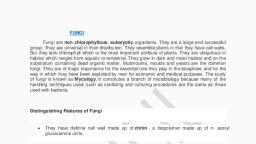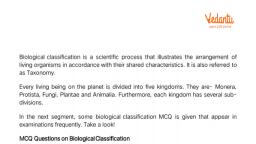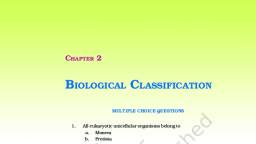Page 1 : Amit Kumar (M.Sc.), 9334789670, , , , , , Biological Classification, , , , , , , , 1. Who was the earliest to attempt a more A. Algae/plants, scientific basis for classification B. Monera, A. Aristotle C. Fungi, B. Hippocrates D. Animalia, C. Charak 8. Which of the following is/are incorrect, D. Linnaeus statement regarding bacteria, 2. Two Kingdom system of classification A. Bacteria are the sole members of, with Plantae and Animalia kingdoms was the Kingdom Monera, developed by 8. Bacteria occur almost everywhere, A. Aristotle and most abundant microB. Hippocrates organisms, C. Charak C. They cannot live in hot springs &, D. Linnaeus deep oceans, 3. The main criteria for classification used D. None of these, by R.H. Whittaker include 9. The rod-shaped bacteria are grouped in, A. Cell structure & bady organisation A. Coccus, B. Mode of nutrition & reproduction B. Bacillus, C. Phylogenetic relationships, C. Vibrium, D. Allofthese D. Spirillum, 4, Five kingdoms classification include 10. Which of the following group show the, A. Monera, protozoa, fungi, plantae & most extensive metabolic diversity, animals A. Plants, B. Archaea; protozoa, fungipplantae, B. Humans, & animalia C. Batteria, C. Monera, protista, fungi, plantae; D. Fungi, &animalia 11. Bacteria may be, D. Eubacteria,protista, fungi, plantae A Autotrophic, & animals B._ Heterotrophic, 5. Robert Harding Whittaker proposed C, Chemosynthetic, a Five Kingdom Classificationin - D. BothA&B, A, 1959 12. Match the followings, B, 1920 i. Thermoacidophiles a, Heterotrophs, Cc. 1980 ii. Halophiles b. Marshy area, D. 1969 iii. Most bacteria c. Hot springs, 6. All unicellular organisms were placed in iv. Methenogens d. Salty area, Kingdom A. ivb, tied, A. Monera B. i-c, ii-b, ii, B. Protista C. ive, ii-d, iiiC. Fungi D. i-b, ii-d, iii-c, iv-a, D. Either AorB 13. Which of the following organisms live in, 7. Kingdom Protista has brought together some of the most harsh habitats, Chlamydomonas & Chlorella while in A. Archaebacteria, earlier classification system these were B. Bacteria, placed in- C. Fungi, ADDRESS - THE ERUDITE. (1) Anishabad Patna-2, (2) Kankarbagh Patna-20 Page 1, , Mob : +91-9334789670,9431408970, Contact us at
[email protected]
Page 2 :
Amit Kumar (M.Sc.), 9334789670, , , , , , D. Protozoans, 14. Which of the following bacteria are, present in the gut of several ruminant, animals, A. Cyanobacteria, B. Archaebacteria, C. Methenogens, D. Halophiles, 15. Which bacteria are responsible for the, production of methane, A. BGA, B, Methenogens, C. Eubacteria, D. Nostoc, 16. Archaebacteria differ from other bacteria, in having, . Different cellular organisation, Different mode of reproduction, Both A&B, Different cell wall & cell, membrane structure, 17. Presence of a rigid cell wall is, characterised by, A. Animals, B. Eubacteria, C. Halophiles., D. Archaebacteria, 18, The BGA have which types of, chlorophyllA. Chha, B. Chib, Cc. Chic, D. Chi.d, 19. Which of the following bacteria are, photosynthetic autotrophes, A. Halophils, B, Nitrobacter, C. Cyanobacteria, D. Allof these, 20. Atmospheric nitrogen fixing bacteria have, specialised cells called, A. Archaeocytes, B. Bacteriocytes, C. Monocytes, D. Heterocysts, 21. Which of the following statement is, incorrect regarding mycoplasma, A. lack a cell wall, , vOm>, , , , ADDRESS - THE ERUDITE. (1) Anishabad Patna-2,, Mob : +91-9334789670,9431408970, Contact us at mnt.jeti¢gmail.com, , , , (2) Kankarbagh Patna-20 Page 2, , B. the smallest living cells, C. can survive without oxygen, D. None of these, 22. Citrus canker is a citrus plant, disease caused by Xanthomonas, axonopodis, which is a, A. Fungus, B. Bacterium, C. Algae, D. Protista, 23. Which of the following kingdom forms a, link with the others dealing with plants,, animals and fungi., A. Monera, B. Archaea, C. Protista, D. Plantae, 24, Eubacteria play a greatrole in recycling, nutrients likeA. Nitrogen, B. Sulphur &lron, C. Phosphorous, D. Allofabove, 25, All single-celled eukaryotes are placed, ‘under A. Monera, B) Protista, C.. Fungi, D. Animalia, 26. Diatoms and golden algae (desmids) are, included inA. Blue green algae, B. Protista, C. Chrysophytes, D. Pyrrophytes, 27. Choose incorrect statement regarding, desmids, A. They are plankton, B. They are photosynthetic, C. Having flagella, D. BothA&C, 28. Frustule is referred to as, Cell wall of dinoflagellate, Siliceous cell wall of diatoms, Soap box like shell of pyrrophytes, . Algae cell wall, , DOw>
Page 3 :
Amit Kumar (M.Sc.), , , , , , 9334789670, 29, Diatomaceous earth is made up of C. Pyrodinium, A. Hydrated silicon dioxide D. BothA&C, , B, Diatoms, C. Calcium silicate, D. Cell wall, 30, Which of the followings are the chief, ‘producers’ in the oceans, A. Euglena, B. Dinoflagellate, C. Diatoms, D. Green algae, 31. Soll of diatomaceous earth is used in, A. Polishing, B. Oil filtration, C. Syrup filtration, D. Allof the above, 32. Dinoflagellate has stiff cell wall plates,, which is made of, A. Chitin, B. Cellulose, C, Silica, D. Protein, 33. How many flagella are/is present in, dinoflagellate, A. Two, B. Three, C. One, D. No flagella, 34. Dinoflagellates are —, A. Saprobic, B. Holozoic, C. Decomposer, D. Photosynthetic, 35. Gonyaulax is, A, Red algae, B. Brown dinoflagellate, C. Brown desmids, D. Red dinoflagellate, 36. Red tide is caused due to rapid, multiplication in, A. Gymnodinium, B. Gonyaulax, C. Red dinoflagellates, D. Allofthe above, 37. Which of the following dinoflagellate, produce saxitoxinthat kill fishes, A. Gonyaulax & Gymnodinium, B. Noctiluca, , Se, ADDRESS - THE ERUDITE. (1) Anishabad Patna-2,, Mob : +91-9334789670,9431408970, Contact us at mnt.jeti¢gmail.com, , 38, Majority of Euglena are found in, , 39, Euglena body is flexible due to presence, , 40. Which of the following groups are, , 41, The pigments of euglenoids are identical, , 42, Which of the following is saprophytic, , 43, Under suitable conditions, slime mould, , 44. During unfavourable conditions, the, , , , (2) Kankarbagh Patna-20 Page 3, , A. Fresh water, , B. Marine water, C. Brackish water, D. Deep sea, , ofA. Murein, B. Chitin layer, C, Pellicle, D. Chloroplast, , photosynthetic in the presence of, sunlight, when deprived of sunlight they, behave like heterotrophs, A. Diatoms, , B. Algae, , C._ Dinoflagellate, , D. Euglenoid, , to those present in, A. Algae, B. Photosynthetic protists, C, Higher plants, D. Fungi, , protists, A. Slime moulds, B- Paramecium, €. Dinoflagellate, D.Diatoms, , form an aggregation, which may grow and, spread over several feet, which is called, , A. Plasmodium, , B. Filamentous, , C. Spores, , D. Tissue, , plasmodium differentiates and forms, fruiting bodies bearing spores. Under, favourable condition these spores are, dispersed by, A. Water current, , B. Air current, , C. Insects
Page 4 :
Amit Kumar (M.Sc.), , , , , , 9334789670, DO. Human beings B. Mosquito, 45. Spores of which of the following protist C. Paramoecium, posses true cell wall D. Histolytica, A. Euglena 53. Which of the following statement/s is/are, , B. Dinoflagellate, C. Slime mould, D. Amoeba, 46, Which of the following are believed to be, primitive relatives of animals?, A. Archaebacteria, B. Slime moulds, C. Fungus, D. Protozoans, 47. Amoeboid protozoans move and, capture their prey by, A. Plasma gel, B. Pseudopodia, C. Flagella, D. Cilia, 48. Which of the following amoeboid, protozoans are parasitesA. Amoeha, B. Entamoeba, C. Plasmodium, D. Trypanosoma, 49, Sleeping sickness is caused by, A. Leishmania, B.. Trypandsoma, C. Plasmodium, D. Donovani, 50. In paramoecium which of following, causes the water laden with food to be, steered into the gullet., A. Coordinated movement of Cilia, B, Coordinated movement of Flagella, C. Pseudopodia formation, D. Constriction, 51. Which of the following protozoa have an, infectious spore-like stage in their life, cycle, A. Entamoeba, B. Trypanosoma, C. Sporozoans, D. Ciliated protozoans, 52. Which of the following is the most, notorious sporozoans which cause, malaria A. Plasmodium, , Se, ADDRESS - THE ERUDITE. (1) Anishabad Patna-2,, Mob : +91-9334789670,9431408970, Contact us at mnt.jeti¢gmail.com, , , , incorrect, A. Fungi show a great diversity in, morphology and habitat, B. The common mushroom you eat, and toadstools are also fungi, C. White spots seen on mustard, leaves are due to a saprobic, fungus, D. None of these, 54. Yeasts are A. Unicellular, B. Coenocytic, C. Ascomycetes, D. BothA&C, 55, Fungi prefer to grow in A. Warm & brackish water, B. Cold &salty water, C. Cold &moist place, D, Warm & humid place, 56. In fungi , the network of hyphae is known, as, A. Stalk, B. Filamentous, C, Thallus, D. Mycelium, 57. Some hyphae of fungi are continuous, tubes filled with multinucleated, cytoplasm ~ these are called, A Syncytium, B. Archaeocyte, C. Coenocytic, D. None of these, 58. The cell walls of fungi are composed of, A. Galactan & Mannan, B. Chitin, C. Polysaccharides, D. BothB&C, 59, Fungi may beA. Saprophytes, B. Parasites, C. Symbionts, D,. A,Borc, 60. Fungus associated with root of vascular, plants is called, , (2) Kankarbagh Patna-20 Page 4












































